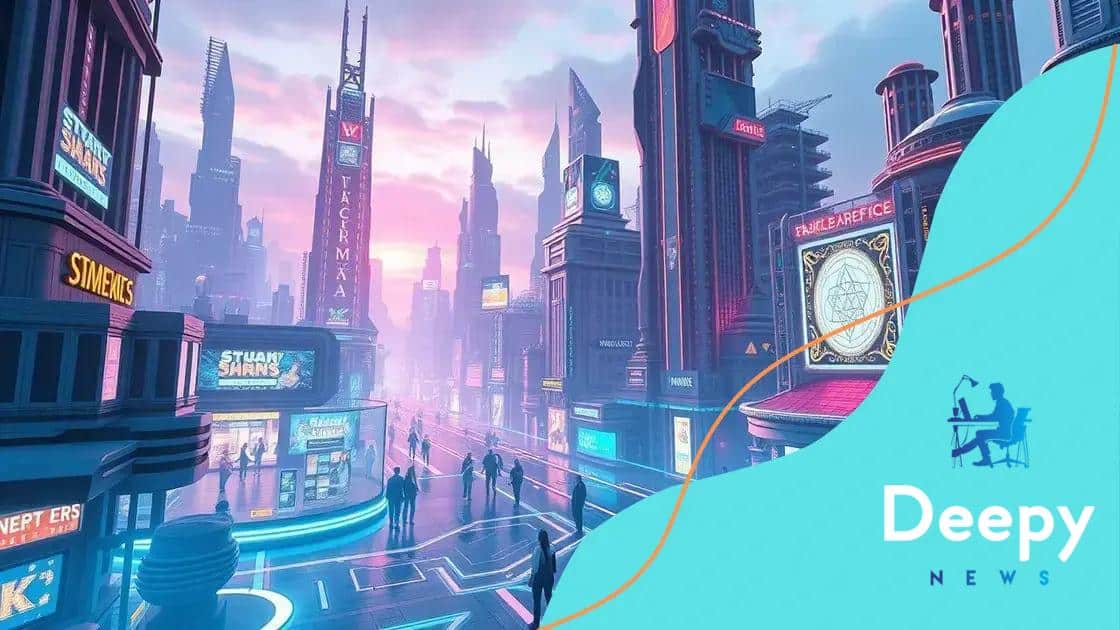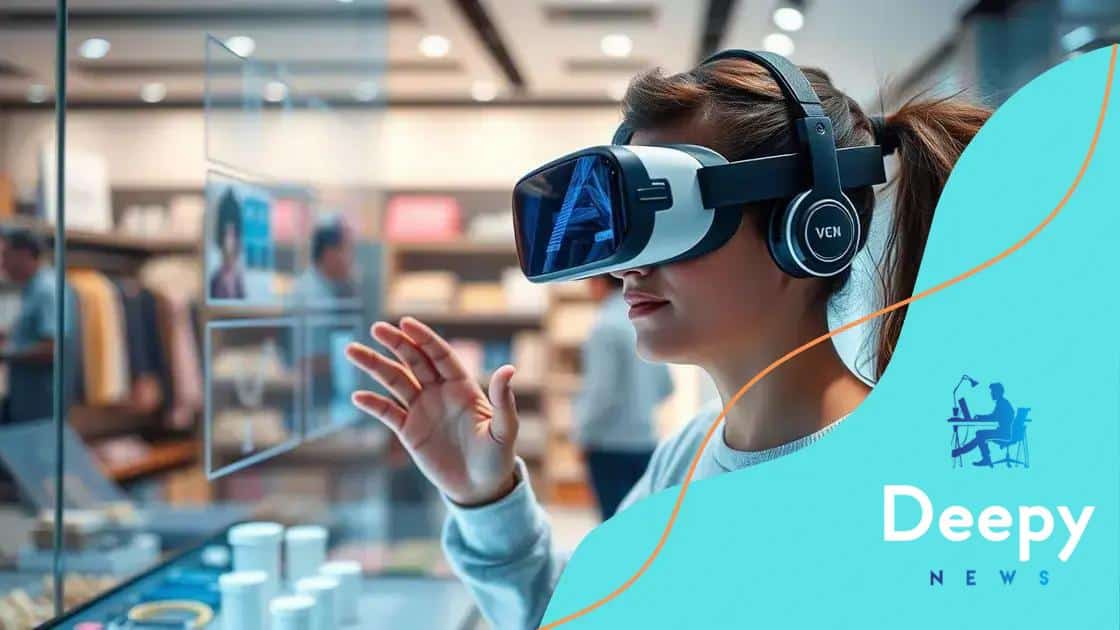How the metaverse is influencing digital economies

The metaverse is transforming digital economies by creating immersive experiences, enhancing customer engagement, and generating new job opportunities while presenting challenges like user safety and technology access.
How the metaverse is influencing digital economies is a question that many are starting to ask. As virtual environments become more immersive, they open up new avenues for businesses and consumers alike. Have you thought about how this transformation might change your daily life?
Understanding the metaverse concept
Understanding the metaverse concept can feel overwhelming at first, but it’s essential to grasp how it impacts our digital lives. The metaverse is more than just virtual reality; it’s a collective virtual space where physical and digital realities converge.
This space offers numerous opportunities for connection and interaction. As users immerse themselves in this vibrant environment, they can experience a unique blend of social interactions and economic transactions.
Key Features of the Metaverse
Several key features define the metaverse and contribute to its growing popularity:
- Interoperability: Different virtual environments can connect, allowing users to move seamlessly between them.
- Persistent world: The metaverse continues to exist and evolve, even when you log off.
- User-generated content: Users can create and share their own experiences and environments, contributing to a dynamic ecosystem.
- Immersive experiences: Advanced technologies, like VR and AR, make interactions more engaging and realistic.
As you delve deeper into the metaverse, it becomes clear this concept transcends traditional social media. Imagine attending events, exploring virtual worlds, and participating in economic activities, all from the comfort of your home. The potential for new experiences is immense.
Moreover, the metaverse also promotes collaboration among its users. From virtual meetings to co-working spaces, the ways to interact are diverse and innovative. As communities grow, so too do opportunities for learning, creativity, and connection.
Envisioning the future of the metaverse involves recognizing its evolution. As technology advances, the definitions of space and interaction will continue to change. This exciting landscape offers a glimpse into how our economy might look in coming years, proving that the metaverse isn’t just a trend, but a significant shift in our technological landscape.
Key features of digital economies
Key features of digital economies play a critical role in shaping how business is conducted online. Understanding these features can help individuals and businesses thrive in today’s fast-paced environment.
The rise of digital technologies has transformed traditional economic models. As consumers increasingly turn to the internet for shopping and services, businesses must adapt to meet these new demands.
Essential Elements of Digital Economies
Some of the essential elements that define digital economies include:
- Connectivity: The internet enables businesses and consumers to connect globally, breaking geographical barriers.
- Data-driven decisions: Companies now rely on data analytics to make informed choices about products and marketing strategies.
- Accessibility: Digital platforms allow people from various backgrounds to access resources and opportunities.
- Scalability: Businesses can grow rapidly without being limited by physical space or inventory.
As we delve deeper into digital economies, innovation emerges as a key driver. Companies are constantly developing new technologies to improve operations and enhance customer experiences. From mobile payment systems to e-commerce platforms, the possibilities are vast.
Moreover, digital economies emphasize collaboration. Businesses and consumers can interact and collaborate through online platforms, leading to the creation of communities. These connections foster engagement and loyalty among customers, which is invaluable in a competitive market.
Understanding the features of digital economies will help you navigate this new landscape effectively. Embracing technology and shifting mindsets can lead to significant advantages for businesses and consumers alike.
The role of virtual reality in commerce

The role of virtual reality in commerce is becoming increasingly important. This innovative technology is changing how businesses engage customers and enhance shopping experiences. By offering immersive environments, virtual reality (VR) allows consumers to interact with products like never before.
Incorporating VR into the shopping process, retailers can provide a unique way for customers to explore products from the comfort of their homes. Imagine trying on clothes or viewing furniture in your own space before making a purchase.
Benefits of Virtual Reality in Commerce
Several benefits highlight the significance of virtual reality in the commercial sector:
- Enhanced customer engagement: Businesses can create interactive experiences that keep customers involved.
- Informed purchasing decisions: VR helps customers visualize products, leading to more confident buying choices.
- Reduced return rates: When customers can experience products virtually, they are less likely to return items.
- Creative marketing opportunities: Brands can use VR for compelling storytelling, enhancing brand visibility.
As companies embrace this technology, the landscape of e-commerce is continuously evolving. Virtual reality not only enhances customer experiences but also fosters a stronger connection between brands and consumers.
In addition to improving customer interaction, virtual reality can streamline training for employees. Staff can practice selling techniques or customer service skills in simulated environments, ensuring they’re better prepared for real-life situations.
Overall, the integration of virtual reality in commerce presents exciting possibilities. As technology advances, the retail experience will only become more immersive and engaging for customers, reshaping the future of shopping.
Impact on job creation and skills development
The impact of the metaverse on job creation and skills development is significant as industries adapt to new technologies. As businesses transition to virtual environments, they require a workforce equipped with different skill sets.
New job opportunities are emerging in various fields, especially in technology and digital marketing. Companies are seeking talent skilled in virtual reality, augmented reality, and other related technologies. These fields are not just about creating new experiences but also about enhancing traditional roles.
Emerging Job Roles in the Metaverse
As the metaverse grows, several new job roles are becoming prominent:
- 3D Modelers: These professionals create virtual environments and objects, bringing digital spaces to life.
- Virtual Reality Designers: They focus on designing immersive experiences that engage users and promote interaction.
- Community Managers: As virtual spaces thrive, community managers nurture user engagement and facilitate connections among users.
- Data Analysts: Companies need data experts to track user behavior and optimize experiences within the metaverse.
In tandem with these new roles, existing jobs are evolving. Current employees must adapt to changing technologies and understand how to utilize new tools effectively. Upskilling programs are crucial as they help workers transition into roles that align with the needs of the evolving digital landscape.
Additionally, educational institutions are incorporating metaverse-related content into their curriculums. From online courses to immersive training modules, learning now takes place in innovative and engaging formats. This prepares students to thrive in careers within the metaverse.
Furthermore, job training within virtual environments provides hands-on experiences. Trainees can practice skills in controlled, simulated settings which enhances their learning and confidence.
Challenges and opportunities in the metaverse
Challenges and opportunities in the metaverse are crucial to understand as more companies and individuals explore this digital frontier. While the metaverse offers vast potential, it also presents unique hurdles that require attention.
One major challenge is ensuring user safety. With the rise of virtual environments, concerns over privacy, data security, and cyberbullying have become more prominent. Users need to feel secure in these spaces to interact freely.
Key Challenges Faced in the Metaverse
Several key challenges impact the growth of the metaverse:
- Technology Access: Not everyone has the necessary technology or internet connection to participate in the metaverse.
- Standardization: The lack of unified standards for interoperable experiences can create barriers for users and developers.
- Legal and Ethical Issues: Questions around copyright, ownership, and governance are still being debated.
- Digital Divide: There is a risk that inequalities may deepen as some groups gain access while others remain excluded.
Despite these challenges, the metaverse also opens up numerous opportunities. Businesses can reach global markets through immersive experiences and innovative marketing strategies. Brands are using the metaverse to engage customers in unique ways, turning shopping into an interactive adventure.
Moreover, there is a strong potential for collaboration. The metaverse allows people from different backgrounds to come together easily. This fosters creativity and innovation, as diverse perspectives contribute to new ideas and solutions.
As the landscape evolves, organizations can experiment with new products and services in a virtual space before launching them in the real world. This not only reduces financial risks but also enables companies to gather feedback in real-time, refining their offerings.
The balance between addressing challenges and seizing opportunities will shape the future of the metaverse. Businesses, consumers, and developers all play a vital role in creating a safe and inclusive environment.
FAQ – Frequently Asked Questions about the Metaverse
What are the main benefits of the metaverse for businesses?
The metaverse offers businesses new ways to engage customers, enhance brand visibility, and create immersive shopping experiences.
How does virtual reality impact customer experiences?
Virtual reality allows customers to interact with products in a more immersive way, helping them make informed purchasing decisions and increasing satisfaction.
What challenges does the metaverse face?
Key challenges include user safety, technology access, and the need for standardization and ethical considerations.
How is the metaverse expected to affect job creation?
The metaverse is expected to create new job roles in technology, design, and community management, while also transforming existing roles.






